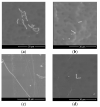Cacao Pod Husk Extract Phenolic Nanopowder-Impregnated Cellulose Acetate Matrix for Biofouling Control in Membranes
- PMID: 34677514
- PMCID: PMC8538598
- DOI: 10.3390/membranes11100748
Cacao Pod Husk Extract Phenolic Nanopowder-Impregnated Cellulose Acetate Matrix for Biofouling Control in Membranes
Abstract
The ultrafiltration membrane process is widely used for fruit juice clarification, yet the occurring of fouling promotes a decline in process efficiency. To reduce the fouling potential in the membrane application in food processing, the use of natural phenolic compounds extracted from cocoa pod husk is investigated. The cocoa pod husk extract (CPHE) was prepared in phenolic nanoparticles form and added into the polymer solution at varying concentrations of 0.5 wt%, 0.75 wt%, and 1.0 wt%, respectively. The composite membrane was made of a cellulose acetate polymer using DMF (dimethylformamide) and DMAc (dimethylacetamide) solvents. The highest permeability of 2.34 L m-2 h-1 bar-1 was achieved by 1.0 wt% CPHE/CA prepared with the DMAc solvent. CPHE was found to reduce the amount of Escherichia coli attached to the membranes by 90.5% and 70.8% for membranes prepared with DMF and DMAc, respectively. It is concluded that CPHE can be used to control biofouling in the membrane for food applications.
Keywords: biofouling; cacao pod husk extract; cellulose acetate; composite membranes; phenolic nanoparticles.
Conflict of interest statement
The authors declare no conflict of interest.
Figures










Similar articles
-
Potential Utilisation of Theobroma cacao Pod Husk Extract: Protective Capability Evaluation Against Pollution Models and Formulation into Niosomes.Trop Life Sci Res. 2024 Jul;35(2):107-140. doi: 10.21315/tlsr2024.35.2.6. Epub 2024 Jul 31. Trop Life Sci Res. 2024. PMID: 39234471 Free PMC article.
-
Hydrophilicity and antifouling property of membrane materials from cellulose acetate/polyethersulfone in DMAc.Int J Biol Macromol. 2016 Oct;91:143-50. doi: 10.1016/j.ijbiomac.2016.05.072. Epub 2016 May 19. Int J Biol Macromol. 2016. PMID: 27211301
-
Removal of chromium (VI) ions from aqueous solutions using amine-impregnated TiO2 nanoparticles modified cellulose acetate membranes.Chemosphere. 2018 Jan;191:673-684. doi: 10.1016/j.chemosphere.2017.10.107. Epub 2017 Oct 22. Chemosphere. 2018. PMID: 29078191
-
Polymers and Solvents Used in Membrane Fabrication: A Review Focusing on Sustainable Membrane Development.Membranes (Basel). 2021 Apr 23;11(5):309. doi: 10.3390/membranes11050309. Membranes (Basel). 2021. PMID: 33922560 Free PMC article. Review.
-
A Journey from June 2018 to October 2021 with N,N-Dimethylformamide and N,N-Dimethylacetamide as Reactants.Molecules. 2021 Oct 21;26(21):6374. doi: 10.3390/molecules26216374. Molecules. 2021. PMID: 34770783 Free PMC article. Review.
Cited by
-
State-of-the-Art Mixed Matrix Membranes (MMMs).Membranes (Basel). 2022 Mar 4;12(3):294. doi: 10.3390/membranes12030294. Membranes (Basel). 2022. PMID: 35323770 Free PMC article.
References
-
- Wibisono Y., Bilad M.R. 3—Design of forward osmosis system. In: Basile A., Cassano A., Rastogi N.K., editors. Current Trends and Future Developments on (Bio-) Membranes. Elsevier; Amsterdam, The Netherlands: 2020. pp. 57–83.
-
- Wibisono Y. Two-Phase Flow for Fouling Control in Membranes. University of Twente; Enschede, The Netherlands: 2014.
-
- Bhattacharjee C., Saxena V.K., Dutta S. Fruit juice processing using membrane technology: A review. Innov. Food Sci. Emerg. Technol. 2017;43:136–153. doi: 10.1016/j.ifset.2017.08.002. - DOI
-
- Baker J.S., Dudley L.Y. Biofouling in membrane systems—A review. Desalination. 1998;118:81–89. doi: 10.1016/S0011-9164(98)00091-5. - DOI
Grants and funding
LinkOut - more resources
Full Text Sources

